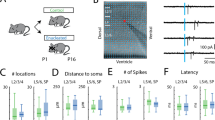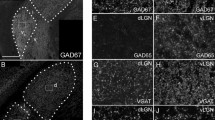Summary
The cat's retinogeniculate pathway, immature at birth, develops physiologically and anatomically over the first three postnatal months. Visual deprivation from birth interferes with this maturation. Thus, monocular eye lid suture from birth leads to pronounced abnormalities in the morphology of retinogeniculate terminations and geniculate neurons, and to a reduction in the proportions of Y-cells recorded physiologically in the lateral geniculate nucleus (e.g. see Sherman and Spear 1982). This “loss” of geniculate Y-cells could possibly be due to reduced retinogeniculate Y-cell terminations and expanded X-cell terminations in the A-laminae (Sur et al. 1982), so that many geniculate cells that normally receive retinal Y-cell input accept and retain retinal X-cell input (Friedlander et al. 1982). Dark-rearing from birth also leads to a reduction in the proportions of Y-cells recorded in the lateral geniculate nucleus (Kratz et al. 1979). Such a loss might also be due to abnormalities in retinogeniculate X- and Y-cell terminations. To test this possibility, we injected horseradish peroxidase into physiologically identified retinogeniculate axons of darkreared cats. Surprisingly, we found that our sample of retinogeniculate X- and Y-cell axons in darkreared cats had normal morphology. If our sample is representative of the entire population of retinogeniculate X- and Y-cell axons, retinogeniculate axon morphology in dark-reared cats differs from that in monocularly sutured cats. Yet, using extracellular recording, we replicated the observation that physiologically identified geniculate Y-cells are encountered less often in dark-reared cats than in normal cats. Given the apparent normality of the retinogeniculate axons in these cats, the “loss” of geniculate Y-cells in dark-reared cats could then conceivably be due to conduction block in retinogeniculate afferents, tonic inhibition on Y-cells, or deficits in non-retinal influences that may importantly affect Y-cell development.
Similar content being viewed by others
References
Adams JD (1977) Technical considerations on the use of horseradish peroxidase as a neuronal marker. Neuroscience 2: 141–145
Bowling DB, Michael CR (1984) Terminal patterns of single, physiologically characterized optic tract fibers in the cat's lateral geniculate nucleus. J Neurosci 4: 198–216
Burchfiel JL, Duffy FH (1981) Role of intracortical inhibition in deprivation amblyopia: reversal by microiontophoresis of bicuculline. Brain Res 206: 479–484
Cleland BG, Levick WR, Sanderson KJ (1974) Properties of sustained and transient ganglion cells in the cat retina. J Physiol (Lond) 228: 649–680
Cynader M (1983) Prolonged sensitivity to monocular deprivation in dark-reared cats: effects of age and visual exposure. Dev Brain Res 8: 155–164
Daniels JD, Pettigrew JD, Norman JL (1978) Development of single-neuron responses in kitten's lateral geniculate nucleus. J Neurophysiol 41: 1373–1393
Enroth-Cugell C, Robson JG (1966) The contrast sensitivity of retinal ganglion cells of the cat. J Physiol (Lond) 187: 516–552
Friedlander MJ (1982) Structure of physiologically classified neurones in the kitten dorsal lateral geniculate nucleus. Nature 300: 180–183
Friedlander MJ, Stanford LR, Sherman SM (1982) Effects of monocular deprivation on the structure/function relationship of individual neurons in the cat's lateral geniculate nucleus. J Neurosci 2: 321–330
Garraghty PE, Frost DO, Sur M (1985) Physiologically identified retinogeniculate axons develop normally in dark-reared cats. Soc Neurosci Abstr 11: 1015
Garraghty PE, Sur M, Sherman SM (1986a) The role of competitive interactions in the postnatal development of X and Y retinogeniculate axons. J Comp Neurol 251: 216–239
Garraghty PE, Sur M, Weller RE, Sherman SM (1986b) The morphology of retinogeniculate X and Y axon arbors in monocularly enucleated cats. J Comp Neurol 251: 198–215
Hochstein S, Shapley RM (1976) Quantitative analysis of retinal ganglion cell classifications. J Physiol (Lond) 262: 237–264
Hoffmann K-P, Stone J, Sherman SM (1972) Relay of receptivefield properties in dorsal lateral geniculate nucleus of the cat. J Neurophysiol 35: 518–531
Innocenti GM, Frost DO, Illes J (1985) Maturation of visual callosal connections in visually deprived kittens: a challenging critical period. J Neurosci 5: 255–267
Kalil R (1978a) Dark rearing in the cat: effects on visuomotor behavior and cell growth in the dorsal lateral geniculate nucleus. J Comp Neurol 178: 451–467
Kalil R (1978b) Development of the dorsal lateral geniculate nucleus in the cat. J Comp Neurol 182: 265–292
Kratz KE (1982) Spatial and temporal sensitivity of lateral geniculate cells in dark-reared cats. Brain Res 251: 55–63
Kratz KE, Sherman SM, Kalil R (1979) Lateral geniculate nucleus in dark-reared cats: loss of Y cells without changes in cell size. Science 203: 1353–1355
Loop MS, Sherman SM (1977) Visual discrimination during eyelid closure in the cat. Brain Res 128: 329–339
Maletta GJ, Timiras PS (1968) Choline acetyltransferase activity and total protein content in selected optic areas of the rat after complete light-deprivation during CNS development. J Neurochem 15: 787–793
Mangel SC, Wilson JR, Sherman SM (1983) Development of neuronal response properties in the cat dorsal lateral geniculate nucleus during monocular deprivation. J Neurophysiol 50: 240–264
Mason CA (1982) Development of terminal arbors of retinogeniculate axons in the kitten. I. Light microscopical observations. Neuroscience 7: 541–559
Mower GD, Burchfiel JL, Duffy FH (1981) The effects of dark-rearing on the development and plasticity of the lateral geniculate nucleus. Dev Brain Res 1: 418–424
Mower GD, Caplan CJ, Christen WG, Duffy FH (1985) Dark rearing prolongs physiological but not anatomical plasticity of the cat visual cortex. J Comp Neurol 235: 448–466
Sanderson KJ (1971) The projection of the visual field to the lateral geniculate and medial interlaminar nuclei in the cat. J Comp Neurol 143: 101–117
Shapley R, So YT (1980) Is there an effect of monocular deprivation on the proportions of X and Y cells in the cat lateral geniculate nucleus? Exp Brain Res 39: 41–48
Sherman SM (1985) Functional organization of the W-, X-, and Y-cell pathways in the cat: a review and hypothesis. In: Sprague JM, Epstein AN (eds) Progress in psychobiology and physiological psychology, Vol 11. Academic Press, New York, pp 233–314
Sherman SM, Hoffmann K-P, Stone J (1972) Loss of a specific cell type from dorsal lateral geniculate nucleus in visually deprived cats. J Neurophysiol 35: 532–541
Sherman SM, Koch C (1986) The control of retinogeniculate transmission in the mammalian lateral geniculate nucleus. Exp Brain Res 63: 1–20
Sherman SM, Spear PD (1982) Organization of visual pathways in normal and visually deprived cats. Physiol Rev 62: 738–855
Sur M, Humphrey AL, Sherman SM (1982) Monocular deprivation affects X- and Y-cell retinogeniculate terminations in cats. Nature 300: 183–185
Sur M, Sherman SM (1982) Retinogeniculate terminations in cats: morphological differences between X and Y cell axons. Science 218: 389–391
Sur M, Weller RE, Sherman SM (1984) Development of X- and Y-cell retinogeniculate terminations in kittens. Nature 310: 246–249
Swindale NV, Cynader MS (1986) Physiological segregation of geniculo-cortical afferents in the visual cortex of dark-reared cats. Brain Res 362: 281–286
Torrealba F, Guillery RW, Eysel U, Polley EH, Mason CA (1982) Studies of retinal representations within the cat's optic tract. J Comp Neurol 211: 377–396
Uhlrich DJ, Raczkowski D, Sherman SM (1986) Axonal termination patterns in the lateral geniculate nucleus of retinal X-and Y-cells in cats raised with binocular lid suture. Soc Neurosci Abstr 12: 439
Walsh C, Polley EH, Hickey TL, Guillery RW (1983) Generation of cat retinal ganglion cells in relation to central pathways. Nature 302: 611–614
Author information
Authors and Affiliations
Rights and permissions
About this article
Cite this article
Garraghty, P.E., Frost, D.O. & Sur, M. The morphology of retinogeniculate X-and Y-cell axonal arbors in dark-reared cats. Exp Brain Res 66, 115–127 (1987). https://doi.org/10.1007/BF00236208
Received:
Accepted:
Issue Date:
DOI: https://doi.org/10.1007/BF00236208




